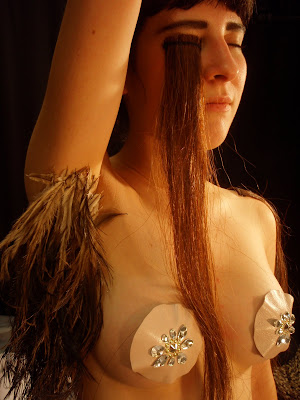- Why participate in the first place?
- Are we only truly naked when we are unable to see the reactions of the individuals we are seen by?
- If an individual is naked are they not still dressed in their 'self'?
"Fashion and clothing are in the business of dressing something up as something else, they take the body and disguise it or present it as something that it is not. Fashion and clothing may be used to mislead to make people respond in ways that they would not or should not"
It is this claim; that fashion and clothing impose meanings on a raw material that either does not originally have any meaning or which has a sort of natural meaning and that through the act of dress we are in a way engaging in a form of participatory or performance art that i aim to explore.
Participation - from the Latin participare (to participate), derived from pars (part) and the root capere (to take).
Participatory art is described as 'situations created by the artist that involve members of the audience as participants or even partners inthe art-making process. Whilst taking into consideration the social systems within which the public engage with art. In a sense, a designer is an artist creating a product in response to a social system or community. And in essence the consumer or target market the audience invited to participate by wearing and get involved and alter through styling or accessorising.
'Artists must recognise that people, as an entity, are the only true artists: "Not ye wise men, therefore, are the true inventors, but the Folk; for want it was that drove it to invention. All great inventions are the People's deed; Whereas the devisings of the intellect are but the exploitations, the derivatives, nay, the splinterings and disfigurements of the great inventions of the Folk." Richard Wagner
Is clothing an aesthetic object separate from the body it encases or does it protect and enhance the human form? A central concern is not only the clothes that cover our bodies but the bodies we recover under our clothes?
If an individual is naked are they not still dressed in them selves - the language they use, the posture they assume, their belongings, their shell.
Our skin - we tan, cover, expose, make-up, tattoo, pierce.
Our hair - we grow, cut, style or colour.
Our nails - we grow, cut, paint and decorate.If one was to be undressed, but still 'wearing' these extensions of self are we not still packaging ourselves in the same way as we do when we wear clothes?
Goffman says "Clothing comes to share in the work of ambivalence management as much as does any other self-communicative device at our disposal: our voices, body postures, and facial expressions and the material objects we surround ourselves with" (1959)
The psychological theory of The Looking Glass Self, a notion brought to light by sociologist Charles Horton Cooley examines the idea that an individual and society or environment do not exist as two separate entities, but rather one is the product of the other. There are three parts to the concept;
- How the individual thinks others perceive them
- How the individual thinks others judge that perception
- and The reaction of the individual to those perceptions and judgements.
Are we then only truly naked when we are unable to see the reactions of the individuals we are seen by?
 The practice of participatory are cannot be discussed within today's society without taking into consideration the free sharing of content epitomised by online communities such as Wikipedia, Facebook, Youtube and Blogging. All such forms of social networking have radically altered the ways in which we relate to each other - not only online, but also as a society.
The practice of participatory are cannot be discussed within today's society without taking into consideration the free sharing of content epitomised by online communities such as Wikipedia, Facebook, Youtube and Blogging. All such forms of social networking have radically altered the ways in which we relate to each other - not only online, but also as a society.These online forums also act as mediums through which we can 'dress' or express ourselves without feeling or viewing the perceptions of others.
Another branch of participatory art i wish to explore is the inclination toward collaborative practice, in order to achieve my outcomes with the highest possible standard i will be working alongside individuals possessing skills in areas i wish to use and don't feel i could execute effectively on my own.


















































